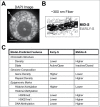Take a look at plant DNA replication: Recent insights and new questions
- PMID: 28375043
- PMCID: PMC5437822
- DOI: 10.1080/15592324.2017.1311437
Take a look at plant DNA replication: Recent insights and new questions
Abstract
Recent advances in replicative DNA labeling technology have allowed new ways to study DNA replication in living plants. Temporal and spatial aspects of DNA replication programs are believed to derive from genomic structure and function. Bass et al. (2015) recently visualized DNA synthesis using 3D microscopy of nuclei at three sub-stages of S phase: early, middle and late. This addendum expands on that study by comparing plant and animal DNA replication patterns, by considering implications of the two-compartment model of euchromatin, and by exploring the meaning of the DNA labeling signals inside the nucleolus. Finally, we invite the public to explore and utilize 300 image data sets through OMERO, a teaching and research web resource for visualization, management, or analysis of microscopic data.
Keywords: 3D microscopy; Chromatin; DNA synthesis; maize; omero; rDNA.
Figures




Erratum for
- Addendum to: Bass HW, Hoffman GG, Lee TJ, Wear EE, Joseph SR, Allen GC, Hanley-Bowdoin L, Thompson WF. Defining multiple, distinct, and shared spatiotemporal patterns of DNA replication and endoreduplication from 3D image analysis of developing maize (Zea mays L.) root tip nuclei. Plant Mol Biol 2015; 89:339-51; http://dx.doi.org/10.1007/s11103-015-0364-4.
References
-
- Zink D. The temporal program of DNA replication: new insights into old questions. Chromosoma 2006; 115:273-87; PMID:16552593; http://dx.doi.org/10.1007/s00412-006-0062-8 - DOI - PubMed
-
- Gilbert DM, Takebayashi SI, Ryba T, Lu J, Pope BD, Wilson KA, Hiratani I. Space and time in the nucleus: developmental control of replication timing and chromosome architecture. Cold Spring Harb Symp Quant Biol 2010; 75:143-53; PMID:21139067; http://dx.doi.org/10.1101/sqb.2010.75.011 - DOI - PubMed
-
- Dileep V, Rivera-Mulia JC, Sima J, Gilbert DM. Large-scale chromatin structure-function relationships during the cell cycle and development: insights from replication timing. Cold Spring Harb Symp Quant Biol 2015; 80:53-63; PMID:26590169; http://dx.doi.org/10.1101/sqb.2015.80.027284 - DOI - PubMed
-
- Bass HW, Wear EE, Lee TJ, Hoffman GG, Gumber HK, Allen GC, Thompson WF, Hanley-Bowdoin L. A maize root tip system to study DNA replication programmes in somatic and endocycling nuclei during plant development. J Exp Bot 2014; 65:2747-56; PMID:24449386; http://dx.doi.org/10.1093/jxb/ert470 - DOI - PubMed
Publication types
MeSH terms
Substances
LinkOut - more resources
Full Text Sources
Other Literature Sources
